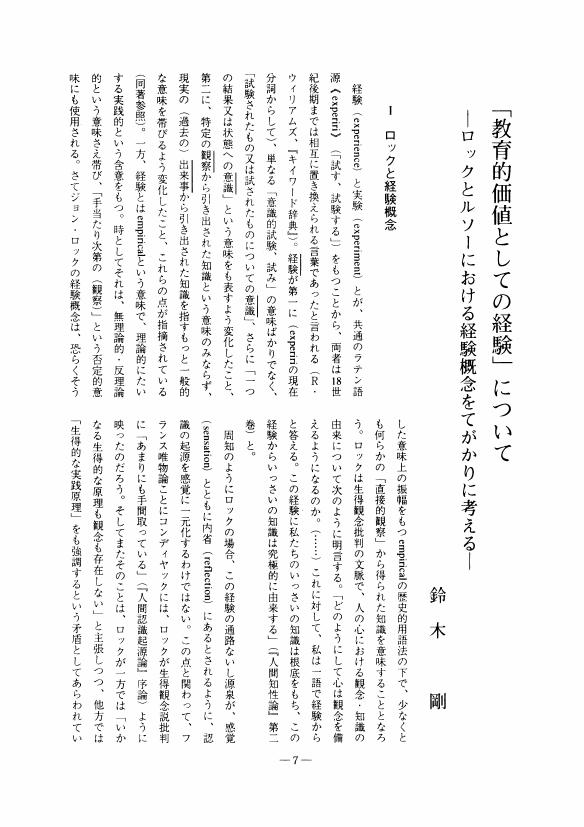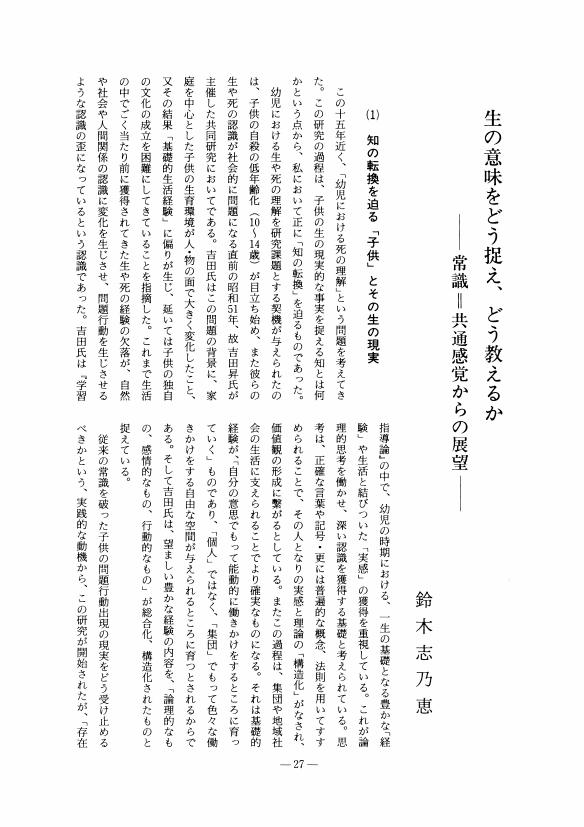1 0 0 0 OA 杉山精一著『初期ヘルバルトの思想形成に関する研究-教授研究の哲学的背景を中心として-』
- 著者
- 鈴木 晶子
- 出版者
- 教育哲学会
- 雑誌
- 教育哲学研究 (ISSN:03873153)
- 巻号頁・発行日
- vol.2001, no.84, pp.126-130, 2001-11-10 (Released:2009-09-04)
- 著者
- 鈴木 志乃惠
- 出版者
- 教育哲学会
- 雑誌
- 教育哲学研究 (ISSN:03873153)
- 巻号頁・発行日
- vol.2000, no.82, pp.103-104, 2000-11-10 (Released:2009-09-04)
1 0 0 0 OA 合わせ鏡としてのモダン/ポストモダン
- 著者
- 鈴木 晶子
- 出版者
- 教育哲学会
- 雑誌
- 教育哲学研究 (ISSN:03873153)
- 巻号頁・発行日
- vol.2000, no.81, pp.6-11, 2000-05-10 (Released:2009-09-04)
1 0 0 0 OA G・オットーの初期著作における自己探求的な芸術教育学理論の基礎づけについての一考察
- 著者
- 鈴木 幹雄
- 出版者
- 教育哲学会
- 雑誌
- 教育哲学研究 (ISSN:03873153)
- 巻号頁・発行日
- vol.1997, no.76, pp.110-123, 1997-11-10 (Released:2009-09-04)
- 参考文献数
- 48
After the Second World War, German padagogues in art education have been obliged to reflect critically on the theories of art education in the 1920s. Confronting new social and educational situations in Germany, they had to keep in mind several new factors such as expression as beings in the world, contemporaneity, adolescence, contact with modern culture and society, and researches by younger generations. G. Otto re-examined the traditional views of art education from the late 1950s through the early 1960s when the reconstruction after the war terminated. He thought that art education should be planned in a social context and struggled hard to build a new theory of art education suited to the time. As the first step, Otto studied pedagogical anthropology, the adolescence and plastic art theories of the 1920s. In this process, he obtained from anthropology the idea that human beings were members of society. From the theories of plastic art, Otto learned that a human being can discover his relationship to the world by the act of production-expression using materials-subjects. These notions were not emphasized in the views of art education from the time of the >new education< plans. The major views which Otto discovered in his early works are as follows : - “One can develop his ability only by keeping in contact with the world.” -Adolescence is the time when one should come into “contact with compounds made up of culture and society of the times.” - “The treatment, study and experiment of materials correspond to the styles of young people's attitudes.” Since 1963 Otto tried to integrate these views into his concept of art education. In that process, he identified the following as the fundamental points of view for integration : - “Struggles with the selected materials are a step of artistic activities for young generations.” - “One opens up the real world on the basis of his categorical views and experiences obtained by himself.” (W. Klafki) In the process of research for the realization of Kunstpädagogik, Otto tried to integrate these two fundamental points of view into one >kunstpädagogische Theorie< on the basis of the heritages of modern didactic theories which were available in the 1950s. One of these was the theory of >kategoriale Bildung< by Klafki, and another was the didactic theory of structural analysis by P. Heimann who asserted that “the process of teaching should be structured as a whole [in order to get a free analytical point of view for education (teaching act)].”
1 0 0 0 OA 浜田栄夫著『表象理論とヘルバルト』
- 著者
- 鈴木 晶子
- 出版者
- 教育哲学会
- 雑誌
- 教育哲学研究 (ISSN:03873153)
- 巻号頁・発行日
- vol.1996, no.73, pp.79-84, 1996-05-10 (Released:2009-09-04)
1 0 0 0 OA 「教育的価値としての経験」について ロックとルソーにおける経験概念をてがかりに考える
- 著者
- 鈴木 剛
- 出版者
- 教育哲学会
- 雑誌
- 教育哲学研究 (ISSN:03873153)
- 巻号頁・発行日
- vol.1995, no.71, pp.7-12, 1995-05-10 (Released:2009-09-04)
1 0 0 0 OA 岡田渥美編『老いと死-人間形成論的考察』
- 著者
- 鈴木 志乃惠
- 出版者
- 教育哲学会
- 雑誌
- 教育哲学研究 (ISSN:03873153)
- 巻号頁・発行日
- vol.1994, no.70, pp.62-63, 1994-11-10 (Released:2009-09-04)
1 0 0 0 OA 影山礼子著『成瀬仁蔵の教育思想-成瀬的プラグマティズムと日本女子大学校における教育』
- 著者
- 鈴木 美南子
- 出版者
- 教育哲学会
- 雑誌
- 教育哲学研究 (ISSN:03873153)
- 巻号頁・発行日
- vol.1994, no.70, pp.55-60, 1994-11-10 (Released:2009-09-04)
- 著者
- 鈴木 幹雄
- 出版者
- 教育哲学会
- 雑誌
- 教育哲学研究 (ISSN:03873153)
- 巻号頁・発行日
- vol.1994, no.69, pp.85-98, 1994-05-10 (Released:2009-09-04)
- 参考文献数
- 40
By clarifying G. Otto (“Kunst als Prozeß im Unterricht”, 1969) as he deals with the problem of how to conceptualize structurally the problem of formative art and education, the task of art pedagogy is realistically approached, i. e. how the young through art education are lead into the world; thus the foundations of art pedagogy are established.At the time when they were established during the latter half of the 1960ies, Otto adopted the viewpoint of production/expression and the theory of the structure of art education (Gestaltungslehre) from the art pedagogue of the Weimar period (1932), A. Erhardt, and through Erhardt he learned about the practice and the theory of Bauhaus. The viewpoint and the theory consisted in 'material/raw material-experiment-montage as the grammar of production/expression.On the basis of this viewpoint and this logic, he developed the following theory of art pedagogy : The meaning of art education can be interpreted as the problem of experimental/inquisitive search in the process of discovery and production. Through this discovery and search the young discover their own expression and a widening of that expression.This paper examines the structure of art pedagogy (“Gestaltungslehre, ” 1932) as an enquiry into Otto's art pedagogy and its theoretical foundations. At the same time, through this enquiry the following process is clarified, i. e. the process is clarified how by overcoming the blind spot of the art education movement, the viewpoint and the logic of production/expression is prepared in various fields of formative art/design/architecture leading to a reform of the art academies and various arts in the 1920ies.
1 0 0 0 OA 「行為の知」への道を探る 学理論の視点から
- 著者
- 鈴木 晶子
- 出版者
- 教育哲学会
- 雑誌
- 教育哲学研究 (ISSN:03873153)
- 巻号頁・発行日
- vol.1993, no.67, pp.6-10, 1993-05-10 (Released:2009-09-04)
- 参考文献数
- 5
1 0 0 0 OA 生の意味をどう捉え、どう教えるか 常識=共通感覚からの展望
- 著者
- 鈴木 志乃恵
- 出版者
- 教育哲学会
- 雑誌
- 教育哲学研究 (ISSN:03873153)
- 巻号頁・発行日
- vol.1993, no.67, pp.27-32, 1993-05-10 (Released:2009-09-04)
1 0 0 0 OA ヘルマン・レールス著 (長谷川守男訳) 『一般教育科学』
- 著者
- 鈴木 晶子
- 出版者
- 教育哲学会
- 雑誌
- 教育哲学研究 (ISSN:03873153)
- 巻号頁・発行日
- vol.1992, no.65, pp.99-102, 1992-05-10 (Released:2009-09-04)
1 0 0 0 OA 西ドイツ・ケルン滞在報告 (一九八二年から一九八九年)
- 著者
- 鈴木 晶子
- 出版者
- 教育哲学会
- 雑誌
- 教育哲学研究 (ISSN:03873153)
- 巻号頁・発行日
- vol.1990, no.62, pp.72-77, 1990-11-10 (Released:2009-09-04)
- 著者
- 鈴木 美南子
- 出版者
- 教育哲学会
- 雑誌
- 教育哲学研究 (ISSN:03873153)
- 巻号頁・発行日
- vol.1990, no.62, pp.83-87, 1990-11-10 (Released:2009-09-04)
1 0 0 0 OA 子供における「死」の理解について 子供が「生きる」ことを知ってゆくこととの関連で
- 著者
- 鈴木 志乃恵
- 出版者
- 教育哲学会
- 雑誌
- 教育哲学研究 (ISSN:03873153)
- 巻号頁・発行日
- vol.1989, no.60, pp.68-71, 1989-11-10 (Released:2009-09-04)
1 0 0 0 OA ジョン・ロックの習慣形成=教育論の特質 身体・意志・知性の関連構造の視点から
- 著者
- 鈴木 剛
- 出版者
- 教育哲学会
- 雑誌
- 教育哲学研究 (ISSN:03873153)
- 巻号頁・発行日
- vol.1989, no.59, pp.59-73, 1989-05-10 (Released:2010-05-07)
- 参考文献数
- 24
Habit formation constitutes an essential viewpoint in John Locke's educational theory. It exercises an influence not only on his educational thought but also on his philosophy and epistemology. In this paper the author has attempted to clarify this theory of habit formation by analyzing Locke's three concepts of body, will and understanding.According to Locke's theory habit is nothing but the habit of Conduct, and Conduct as such is closely related to the body and bodily action as well as to the Understanding. In Locke's “On the Conduct of Human Understanding” (1697) he interprets education as Habit formation, 'obedience of the will to the dictates of Understanding'. Hence it becomes necessary for us to understand the function of will by way of analyzing the 21st chapter, 'On Power', in the second volume of Locke's “An Essay Concerning Human Understanding.” In this book, Locke argues that Will - a spiritual like Understanding - is determined by Uneasiness, Desire, i. e. by Passions. Therefore, in this paper the focus is turned on Locke's Concept of Passions of innate practical principles.
1 0 0 0 OA ヘルバルトの教師養成論-「教育的タクト」を軸に-
- 著者
- 鈴木 晶子
- 出版者
- 教育哲学会
- 雑誌
- 教育哲学研究 (ISSN:03873153)
- 巻号頁・発行日
- vol.1988, no.58, pp.15-27, 1988-11-10 (Released:2009-09-04)
- 参考文献数
- 74
Der Begriff “pädagogischer Takt” spielt bei Herbart eine wichtige Rolle sowohl als Mittelglied zwischen Theorie und Praxis als auch als Beurteilungs-und Entscheidungsvermogen des Erziehers. Herbart erklart die menschiche Entwicklung durch die dialektische Philosophie der Erfahrung, die eine zirkulare Struktur aufweist. In dieser Struktur wird die Empfänglichkeit für die Sinneseindrücke aktiviert und als Erfahrung internalisiert. Dieser Erfahrungsbestand dient als Grundlage aller weiteren Erfahrungen. Der “pädagogische Takt” fungiert in diesem Erfahrungszirkel als ein konstitutives Moment, wodurch er gleichzeitig verfeinert wird.Um die Erfahrung effektiv zu internalisieren, ist philosophisches Denken über die menschliche Natur und Bildsamkeit sowie die Erziehung notwendig. Aus diesem Grund entwickelt Herbart die topisch-kombinatorische Darstellungsweise der Pädgogik, durch die der Lehrer auf die Praxis vorbereiten kann. Herbarts Werk “Allgemeine Pädagogik” stellt als ein Handbuch für Lehrer eine tastende Annäherung an die Erziehungspraxis dar. Bei der Lehrerausbildung orientiert sich Herbart nicht an der Descarteschen modernen Wissenschaft als Grundlage der auf die Praxis bezogenen Pädagogik, sondern an der klassischen Wissenschaft im Sinne der “ars”.
1 0 0 0 OA 戦後改革と宗教教育
- 著者
- 鈴木 美南子
- 出版者
- 教育哲学会
- 雑誌
- 教育哲学研究 (ISSN:03873153)
- 巻号頁・発行日
- vol.1985, no.52, pp.81-84, 1985-11-10 (Released:2009-09-04)
1 0 0 0 OA 子供における死生観の形成について
- 著者
- 鈴木 志乃恵
- 出版者
- 教育哲学会
- 雑誌
- 教育哲学研究 (ISSN:03873153)
- 巻号頁・発行日
- vol.1984, no.50, pp.79-83, 1984-11-10 (Released:2009-09-04)
1 0 0 0 OA 近代教育と宗教をめぐる諸問題 ジョン・ロックの思想に学ぶ
- 著者
- 鈴木 美南子
- 出版者
- 教育哲学会
- 雑誌
- 教育哲学研究 (ISSN:03873153)
- 巻号頁・発行日
- vol.1984, no.50, pp.60-64, 1984-11-10 (Released:2009-09-04)















